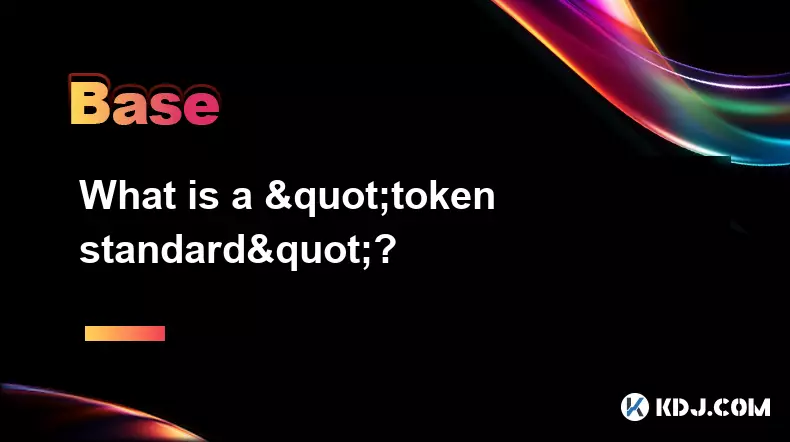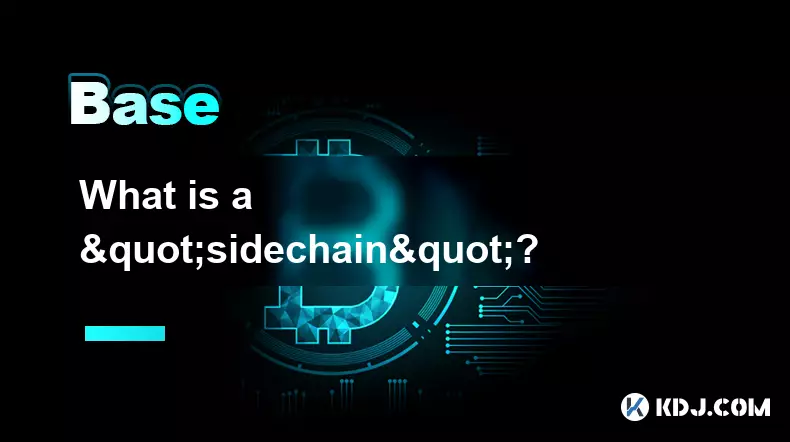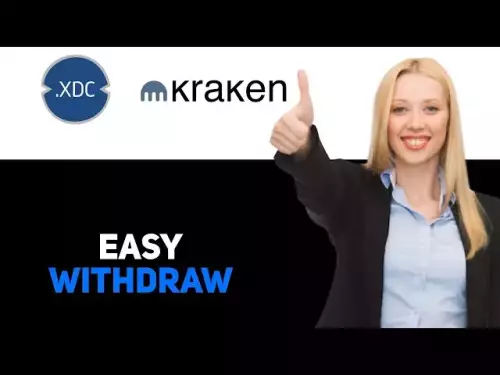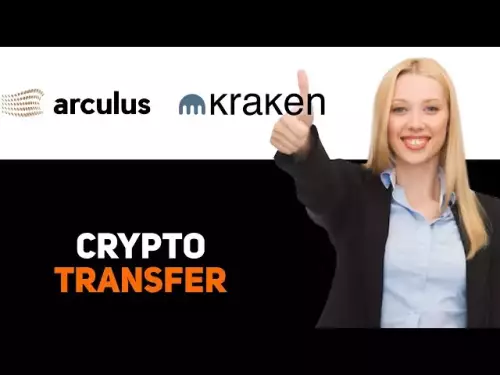-
 bitcoin
bitcoin $114684.631706 USD
-0.87% -
 ethereum
ethereum $4228.677447 USD
1.58% -
 bnb
bnb $1294.880693 USD
-1.16% -
 tether
tether $1.000819 USD
-0.02% -
 xrp
xrp $2.605138 USD
2.79% -
 solana
solana $209.908690 USD
5.89% -
 usd-coin
usd-coin $0.999903 USD
-0.03% -
 dogecoin
dogecoin $0.213423 USD
2.93% -
 tron
tron $0.322721 USD
-0.10% -
 cardano
cardano $0.727247 USD
3.66% -
 hyperliquid
hyperliquid $42.339456 USD
6.05% -
 chainlink
chainlink $19.910811 USD
5.16% -
 ethena-usde
ethena-usde $1.000557 USD
0.00% -
 stellar
stellar $0.349734 USD
2.69% -
 bitcoin-cash
bitcoin-cash $543.848687 USD
-0.21%
What is a "token standard"?
Token standards like ERC-20 and ERC-721 ensure interoperability across blockchains, enabling seamless DeFi integration, NFT creation, and cross-platform compatibility.
Oct 14, 2025 at 09:00 am

Understanding Token Standards in the Cryptocurrency Ecosystem
1. A token standard refers to a set of rules and functions that define how a cryptocurrency token operates within a blockchain network. These standards ensure that tokens are compatible with wallets, exchanges, and decentralized applications. By following a specific standard, developers can create tokens that interact seamlessly across platforms without requiring custom integration for each use case.
2. One of the most well-known examples is the ERC-20 standard on the Ethereum blockchain. It outlines functions such as transferring tokens, querying account balances, and approving token spending. This uniformity allows any ERC-20 token to be traded on decentralized exchanges like Uniswap or stored in MetaMask without compatibility issues.
3. Token standards also govern metadata associated with tokens, including name, symbol, and decimal precision. For instance, a token might have 18 decimals like Ether, allowing for fine-grained transactions, while another may only support six decimals. These specifications are embedded directly into the standard to maintain consistency across implementations.
4. Beyond fungible tokens, standards exist for non-fungible tokens (NFTs), such as ERC-721 and ERC-1155. ERC-721 enables the creation of unique digital assets where each token has distinct properties, commonly used in digital art and collectibles. In contrast, ERC-1155 supports both fungible and non-fungible tokens within a single contract, improving efficiency for gaming and multi-asset platforms.
5. Interoperability is a key benefit of adhering to token standards. When projects build on established protocols, they gain access to existing infrastructure, liquidity pools, and user bases. This reduces development time and increases adoption potential, making standardized tokens more attractive to users and investors alike.
Major Blockchain Platforms and Their Token Standards
1. Ethereum remains the pioneer in defining widely adopted token standards. Its ERC-20, ERC-721, and ERC-1155 have become blueprints for other blockchains. Developers launching tokens on Ethereum typically choose one of these standards based on their project’s requirements for fungibility and functionality.
2. Binance Smart Chain (BSC) uses BEP-20, a standard functionally similar to ERC-20 but optimized for BSC's consensus mechanism and lower transaction fees. Projects migrating from Ethereum often adapt their smart contracts to comply with BEP-20, enabling cross-chain compatibility through bridges.
3. Solana implements its own token standard called SPL (Solana Program Library), which supports both fungible and non-fungible tokens. SPL tokens benefit from Solana’s high throughput and low latency, making them suitable for high-frequency trading and real-time applications.
4. Cardano utilizes native tokens under its Mary hard fork, allowing multiple assets to be created without needing separate smart contracts. This approach differs from Ethereum’s model by embedding token logic at the protocol level, enhancing security and reducing deployment complexity.
5. Polkadot supports tokens through its parachain ecosystem, where each chain can define its own standard using the Substrate framework. However, interoperability between parachains is facilitated via cross-consensus messaging (XCM), ensuring tokens can move across different networks within the Polkadot ecosystem.
The Role of Token Standards in Decentralized Finance (DeFi)
1. In DeFi, token standards enable composability—the ability for different financial applications to integrate and build upon one another. Lending platforms like Aave rely on ERC-20 tokens to calculate collateral values and interest rates, knowing that all compliant tokens expose the necessary data interfaces.
2. Yield farming strategies often involve staking multiple token types across various protocols. Standardization ensures that governance tokens, stablecoins, and reward tokens can be processed uniformly, regardless of their origin within the DeFi landscape.
3. Automated market makers (AMMs) depend heavily on token standards to create liquidity pools. When users provide liquidity, the AMM must verify token balances, allowances, and transfer permissions—all made possible by standardized functions defined in ERC-20 or equivalent protocols.
4. Flash loans, a unique DeFi innovation, require borrowers to return funds within a single transaction block. The execution relies on precise token behavior; any deviation from expected standards could result in failed transactions or exploited vulnerabilities.
5. Cross-chain DeFi platforms use wrapped versions of tokens (e.g., wBTC, wETH) that conform to local standards on alternate chains. These wrappers act as proxies, maintaining parity with the original asset while complying with the technical specifications of the target blockchain.
Frequently Asked Questions
What happens if a token does not follow a recognized standard?A token that deviates from established standards may face limited support. Wallets might not display it correctly, exchanges may refuse listing, and smart contracts could fail to interact with it due to missing functions or unexpected behaviors.
Can a token belong to multiple standards simultaneously?Yes, certain standards like ERC-1155 are designed to handle multiple token types within one contract. Additionally, some tokens implement features from several standards—for example, supporting both ERC-20 and ERC-721 functions—though this requires careful coding to avoid conflicts.
How do developers choose which token standard to use?The choice depends on the blockchain platform, intended use case, and desired functionality. Fungible utility tokens typically use ERC-20 or BEP-20, while NFTs use ERC-721 or SPL. Projects prioritizing gas efficiency or multi-token capabilities may opt for ERC-1155 or native asset models.
Disclaimer:info@kdj.com
The information provided is not trading advice. kdj.com does not assume any responsibility for any investments made based on the information provided in this article. Cryptocurrencies are highly volatile and it is highly recommended that you invest with caution after thorough research!
If you believe that the content used on this website infringes your copyright, please contact us immediately (info@kdj.com) and we will delete it promptly.
- XRP Price Prediction: Weekend Rollercoaster or Rally?
- 2025-10-12 08:45:16
- Bittensor (TAO): Super Bullish Signals Point to Potential 2x Rally
- 2025-10-11 10:25:12
- Silver Price Correction: Navigating the Dip & Identifying Key SEO Keywords
- 2025-10-11 10:25:12
- Decoding Crypto Trends: Bittensor's Bull Run, Cardano's Dip, and LivLive's Presale Buzz in 'Uptober 2025'
- 2025-10-12 08:45:16
- MoonBull: The Crypto Meme Coin Promising 1000x Gains?
- 2025-10-11 10:30:01
- Crypto Payroll Revolution: Stablecoins, Altcoins, and the Future of Salary Payments
- 2025-10-11 10:30:01
Related knowledge

How do decentralized identity (DID) solutions work?
Oct 14,2025 at 11:36pm
Understanding Decentralized Identity in the Blockchain Ecosystem1. Decentralized identity (DID) solutions are built on blockchain networks, allowing i...

What does it mean for code to be "open source" in crypto?
Oct 12,2025 at 01:54pm
Understanding Open Source in the Cryptocurrency Ecosystem1. In the context of cryptocurrency, open source refers to software whose code is publicly ac...

What is the purpose of a "testnet"?
Oct 12,2025 at 09:01am
Understanding the Role of Testnets in Blockchain Development1. A testnet serves as a parallel version of a blockchain network, designed specifically f...

How to avoid phishing scams in crypto?
Oct 13,2025 at 06:18pm
Understanding Common Crypto Phishing Tactics1. Cybercriminals frequently use fake websites that mirror legitimate crypto exchanges or wallet platforms...

What is the difference between single-collateral and multi-collateral Dai?
Oct 12,2025 at 05:18pm
Understanding Single-Collateral Dai1. Single-Collateral Dai (SCD) was the original version of the Dai stablecoin launched by MakerDAO in 2017. It allo...

What is a "sidechain"?
Oct 13,2025 at 02:36pm
Understanding the Concept of Sidechains1. A sidechain is a blockchain that operates independently but is connected to another blockchain, known as the...

How do decentralized identity (DID) solutions work?
Oct 14,2025 at 11:36pm
Understanding Decentralized Identity in the Blockchain Ecosystem1. Decentralized identity (DID) solutions are built on blockchain networks, allowing i...

What does it mean for code to be "open source" in crypto?
Oct 12,2025 at 01:54pm
Understanding Open Source in the Cryptocurrency Ecosystem1. In the context of cryptocurrency, open source refers to software whose code is publicly ac...

What is the purpose of a "testnet"?
Oct 12,2025 at 09:01am
Understanding the Role of Testnets in Blockchain Development1. A testnet serves as a parallel version of a blockchain network, designed specifically f...

How to avoid phishing scams in crypto?
Oct 13,2025 at 06:18pm
Understanding Common Crypto Phishing Tactics1. Cybercriminals frequently use fake websites that mirror legitimate crypto exchanges or wallet platforms...

What is the difference between single-collateral and multi-collateral Dai?
Oct 12,2025 at 05:18pm
Understanding Single-Collateral Dai1. Single-Collateral Dai (SCD) was the original version of the Dai stablecoin launched by MakerDAO in 2017. It allo...

What is a "sidechain"?
Oct 13,2025 at 02:36pm
Understanding the Concept of Sidechains1. A sidechain is a blockchain that operates independently but is connected to another blockchain, known as the...
See all articles

























![[4K 60fps] Prisma by novichokk (1 Coin) [4K 60fps] Prisma by novichokk (1 Coin)](/uploads/2025/10/14/cryptocurrencies-news/videos/k-fps-prisma-novichokk-coin/68ee49804ba00_image_500_375.webp)
















































